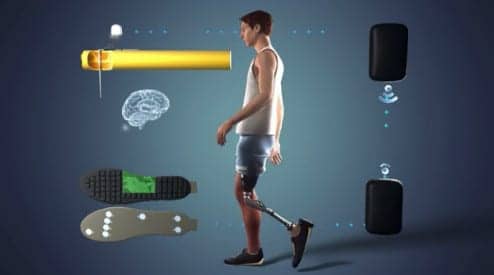
This bionic prosthesis, which was developed by an international team of researchers, features sensors that are designed to connect to residual nerves in the thigh. The resulting neurofeedback greatly reduces physical and mental strain for users of the prosthesis, as well as their phantom limb pain, while increasing their confidence and speed when walking. (Image courtesy of ETH Zurich / Stanisa Raspopovic)
An international team of researchers has developed an interface to connect a leg prosthesis with the residual nerves present in the user’s thigh, thus providing sensory feedback to help control the user’s muscles, help reduce the user’s physical and mental strain while walking, and help reduce phantom limb pain.
In a study conducted in collaboration with the University of Belgrade, the scientists — led by ETH Zurich and Lausanne-based start-up company SensArs — tested this neurofeedback system with two volunteers who have an above-knee leg amputation and use a leg prosthesis.
They report the solution’s benefits in Nature Medicine.
“This proof-of-concept study shows how beneficial it is to the health of leg amputees to have a prosthesis that works with neural implants to restore sensory feedback,” Stanisa Raspopovic, a Professor at the Institute of Robotics and Intelligent Systems at ETH Zurich, says in a media release from ETH Zurich.
To provide the nervous system with sensory information, the scientists began with a commercially available high-tech prosthesis: they attached tactile sensors to the sole of the prosthetic foot, and collected the data on knee movement provided by the prosthesis’s electronic knee joint.
For the three months that the experiment lasted, surgeons placed tiny electrodes in each volunteer’s thigh and connected them to the residual leg nerves.
“The goal of the surgery was to introduce electrodes in the right places inside the nerve to allow the restoration of lifelike sensory feedback, and to allow the stability of the electrodes,” states Marko Bumbasirevic, Professor and orthopaedic microsurgeon at the Clinical Centre of Serbia in Belgrade, who was the clinician responsible for the electrode implant.
The electrodes were developed by scientists from the University of Freiburg, and the prosthesis came from the prosthetic company Össur; both were actively involved in the project.
The research team developed algorithms to translate the information from the tactile and motion sensors into impulses of current – the language of the nervous system – which were delivered to the residual nerve. Then nature does the rest: the signals from the residual nerves are conveyed to the person’s brain, which is thus able to sense the prosthesis and helps the user to adjust their gait accordingly. The machine and the body are finally connected.
As part of the study, the volunteers underwent a series of tests – alternating trials with and without neurofeedback. The results made it very clear just how advantageous the feedback was: walking with neurofeedback was physically much less demanding, as shown by the significant reduction in the volunteers’ oxygen consumption while walking.
Also mentally, ambulation with neurofeedback was less strenuous, as the researchers showed with brain activity measurements during the trials. The volunteers didn’t have to concentrate as hard on their gait, which meant that they were able to devote more of their attention to other tasks.
In one difficult test, the volunteers had to walk over sand, and again the feedback enabled them to walk considerably faster. In surveys, the volunteers stated that the neurofeedback greatly increased their confidence in the prosthesis, the release continues.
The interface with the nervous system can also be used to stimulate the nerves independently of the prosthesis. Before they started the trial, both volunteers complained of phantom limb pain. Over the course of a 1-month therapy program with neurostimulation, the scientists managed to considerably reduce this pain in one of the volunteers; in the other, the pain disappeared completely.
“Since I have started this treatment program, after having received electrical stimulations, I don’t feel any phantom pain,” one of the volunteers says.
The scientists view these outcomes optimistically. However, they point out the need for a longer investigation with in-home assessments and a greater number of volunteers, in order to provide more robust data that they can use to draw more significant conclusions.
For the time-limited clinical study, the signals from the prosthesis were sent along cables through the skin to the electrodes in the thigh. This meant that the volunteers had to undergo regular medical examinations. To eliminate this need, the scientists intend to develop a fully implantable system, the release concludes.
“At SensArs, we’re planning to develop a wireless neurostimulation device that can be fully implanted into the patient like a pacemaker, and that can be brought to the market,” Francesco Petrini, CEO of SensArs notes.
[Source(s): ETH Zurich, EurekAlert]




